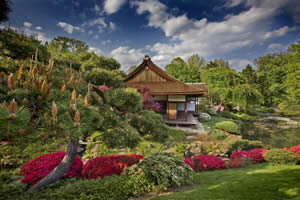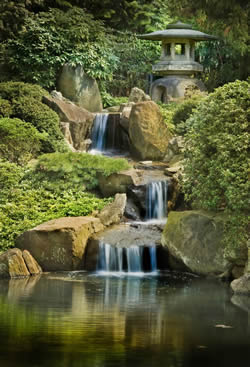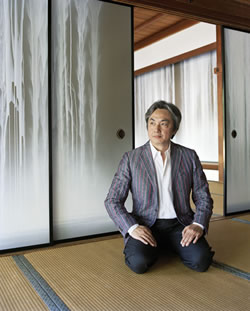
As the full moon passes over the traditional house, one of the most magnificent landscapes is created by the flawless harmony of natural beauty and human creation. This extraordinary landmark, surrounded by cherry trees, azaleas, and Japanese maples, captures imaginations and whisks visitors away into 17th century Japan. Shofuso Japanese House and Garden, an example of authentic traditional Japanese architecture, stands serenely on the grounds of the Horticultural Center of Fairmount Park in West Philadelphia. Shofuso, “pine breeze villa” in Japanese, remains true to its name, as it provides a peaceful retreat away from the busy city.
The Shofuso Japanese House, considered the only house of its kind outside of Japan, was designed by Japanese architect Junzo Yoshimura. With Yoshimura’s help, in 1953, the house was constructed as a gift by the American-Japan Society to the United States for an exhibit in the Museum of Modern Art in New York City. It also stood as a symbolic gesture of a continued positive relationship between Japan and the United States after World War II. Shofuso implements the 17th century shoin-zukuri style Japanese residential architecture, a form that uses square pillars, sliding doors called fusuma panels, and floors covered in tatami mats. Inside the house, sparse furniture creates a simple yet captivating atmosphere. Sparing no detail in the site’s quest for accuracy, the kitchen contains the earthen floors that would have been present in this style of house. Its curved roof, covered in cypress bark, is supported by tall cypress columns. A wooden walkway connects the main house to the traditional tea house.

The house was displayed for two years in New York City until the exhibition closed in 1955. The closing of the exhibit caused a stir, as various cities vied to have Shofuso relocated to them. Philadelphia’s Commercial Museum Board of Trade and Conventions contacted the Museum of Modern Art and strongly recommended the relocation of Shofuso to Fairmount Park. Permission was finally granted, and, in 1958, the exquisite house was reassembled in Philadelphia. By remaining on the East coast, where there were fewer Asian influences, it was hoped that Shofuso would serve as an educational asset to increase awareness of the little-known Oriental culture of the Far East.
Its new location in Philadelphia allowed for the addition of a 17th century style garden. The carefully cultivated garden was the final stage that brought the traditional sights of Japan to Philadelphia, providing the rocks, water, and trees that evoke the country’s mountains, streams, and forests. Designed by Sano Tansai, the garden features a stepping stone pathway, a waterfall and pond filled with turtles and koi fish, and traditional hinoki cypress and bamboo trees. A life-size statue of Jizo, the Buddhist deity for the protection of children, also stands amidst the landscape.
Unfortunately, in the years that followed the relocation, Shofuso was damaged by natural deterioration and vandalism. In 1976, however, in order to honor the United States’ Bicentennial, the Japanese government funded extensive repairs on the house as a gift to America. Then, in 1982, the nonprofit organization Friends of the Japanese House and Garden was formed in order to maintain the property. Since then, Shofuso has been under careful watch and has undergone several other restorations.

In 2006, 20 murals were donated by an internationally-acclaimed Japanese painter, Hiroshi Senju. Senju, known for his style of modernism mixed with the ancient method of Japanese painting, was the first Asian artist to receive an honorary mention at the Venice Biennale, a major contemporary art exhibit in Venice, Italy. When Senju visited Shofuso, he viewed the Japanese house as an architectural masterpiece in which he could “sense the presence of Japan.” In order to enhance the beauty of the interior, his murals were installed on paper sliding doors and on a centerpiece alcove wall, replacing the original pieces by Kaii Higashiyama that were destroyed by vandalism in the 1970s. Senju believes that the “biggest characteristic of Japanese culture is an awareness of being in nature,” and his waterfall-themed murals add the essence of nature into the house. Shofuso is the first and only place in the United States to house such a unique Japanese art installation. Yuichi Ozawa, the President of the Friends of the Japanese House and Garden, was grateful for Senju’s contributions, saying that it is “an amazing contribution to us, to the people of Philadelphia, and to the art world.” This artwork, coupled with the well-maintained architecture, makes the location one of the most captivating sights in Philadelphia.
Today, Shofuso continues to serve its original purpose as a cultural educator. This valuable resource, the only one of its kind in the United States, allows visitors, including architects and artists, to learn about the traditional 17th century shoin-zukuri style house and garden. Gretchen Sturm, a martial artist, first visited Shofuso “as part of training” to “study the different Japanese arts.” Along with the unique display itself, Shofuso has hosted many different educational programs, festivals, and ceremonies reflecting both Japanese history and culture. These ceremonies include the moon viewing festival, the summer festival, a tea ceremony, and storytelling.
Shofuso is truly a unique cultural treasure, a place where visitors can escape their ordinary life and enjoy a true Japanese experience. Shofuso Japanese House and Garden continues to serve as a cultural ambassador to the United States, representing Japan through architecture, culture, and art. In this way, as the former executive director of the Japanese House, Prudence Haines, explained, Shofuso is “a way to escape to Japan without traveling to Japan.”
Sources:
- “Artistic Masterpiece Comes to Shofuso.” Japan America Society of Greater Philadelphia. 2008. 1 Mar. 2010. <http://jasgp.org/content/view/490/179/>.
- Deitz, Paula. “In Philadelphia, Tea and Empathy: Preserving a Museum of Modern Art Show House.” New York Times 1 Aug. 1996: C4.
- “Hiroshi Senju Will Complete Work on Gift of New Murals to Shofuso in 2006.” Shofuso Japanese House and Garden. July 2007. 1 Mar. 2010. <http://www.shofuso.com/?p=243&preview=true>.
- “History.” Shofuso Japanese House and Garden. 12 Nov. 2009. <http://www.shofuso.com/>.
- “In the Community: Shofuso Japanese House and Garden.” Drive. Subaru, Spring 2009. 12 Nov. 2009. <http://drive2.subaru.com/Spr09/Spr09_InTheCom.htm>.
- “Interview #1: Hiroshi Senju.” J-Collabo.com. 20 Mar. 2008. 09 Dec. 2009. <http://j-collabo.com/interviews/hiroshi-senju/>.
- Ozawa, Melissa. “Calm Voyage.” House & Garden Oct. 2007: 118-119.
Photos provided by the Friends of the Japanese House and Garden and George Wildman Photography. The work of the Friends of the Japanese House and Garden may be seen at the Shofuso website.
